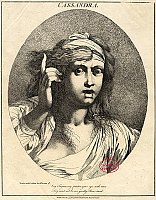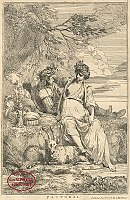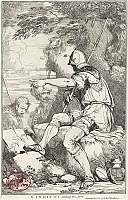 |
|
John Hamilton Mortimer1740 – 1779 |
|
|
Click on a picture for more details |
|
|
A prodigiously talented artist, John Hamilton Mortimer achieved great success throughout his artistic career. He first became established as a portrait painter and, like Henry Fuseli, aspired initially to become a history painter in the grand manner, though Mortimer choose subjects from national history rather than myth and legend. However, around 1770 he struck out with his own highly imaginative style, choosing expressive figure subjects depicting the most extreme aspects of human nature. Working with astonishing speed, John Hamilton Mortimer is reputed to have been able to draw anything he chose directly from his imagination and to have had such knowledge of the human form that he could draw “the human skeleton in any attitude and afterwards, with a different coloured ink, clothe it with muscles”. Mortimer was much inspired by the etchings of Salvator Rosa and he was the first English artist to promote untamed Banditti figures as the heroes of his work, the tragedy associated with these characters according perfectly with the Romantic nature of his art. John Hamilton Mortimer was a wild and flamboyant character who, throughout his youth, led an outrageous lifestyle filled with revelry and excessive drinking. Upon his marriage in 1775 he resolved to amend his ways and abandoned his former behaviour, throwing all of his energies into the pursuit of his art. The following three years proved to be the most productive period of his artistic career and it was at this time that Mortimer embarked upon his series of Shakespeare Characters. These were issued in two groups, each containing six etched characters - the first published in 1775 and the second the following year. These remarkable imaginary characters represent the most important portrait etchings to have been made by this brilliant artist. Soon after the Shakespeare Characters had been completed, Mortimer embarked upon his series of etchings dedicated to Sir Joshua Reynolds which included his famous monster subjects and a variety of his finest etchings of Banditti and allegorical subjects. Published in 1778, these etchings proved to be some of his last works. Sadly, even Mortimer’s athletic constitution could not endure the rigours to which the wild young man had subjected himself in his early days and he yielded to a severe fever, dying at the age of only 38, in early 1779. Despite his short life, the influence of John Hamilton Mortimer’s art, especially through the etchings of his work, has been considerable. He was revered by many of the younger artists of his time, especially William Blake, who regarded him as a radical opponent to Sir Joshua Reynolds and the mainstream of conventional academic art. Even today, the dramatic etching by Joseph Haynes of John Hamilton Mortimer’s Death on a Pale Horse is regarded as one of the seminal British images of Apocalypse. Indeed, John Hamilton Mortimer is now firmly established as one of the key figures in the development of Romantic British art. Almost all of John Hamilton Mortimer’s etchings are now known only through the posthumous printings of T. Palser. Lifetime impressions of Mortimer’s etchings are rare and working proofs of his plates, prior to first publication, are exceptional rarities. [more] |





